
1973 Porsche 911 group test – the full S.E.T. The E- and F-programme 2.4-litre 911s from 1972 and 1973 were graded into three specifications: the S, the E and the T. Like their RS sibling, their values are currently rocketing out of sight: we bring the trio into focus. Words: Johnny Tipler. Photos: Antony Fraser.
Are you in or are you out? There’s a growing band of aficionados of early ’70s 911s, and the ownership profile is shifting. But whether you’re an enthusiast or an investor, if you’ve got one of these cars you’ll probably be rubbing your hands with glee as you watch the values soar.
All air-cooled 911s are appreciating, but none quite as dramatically as the cars made in the decade between 1963 and 1973 and, specifically, the three mainstream models, the S, E, and T, produced in ’72 and ’73. It’s not hard to figure out why. ‘The 2.4-litre cars are so popular at the moment because they are the harbingers of the 2.7 Carrera RS launched the same year,’ declares specialist Paul Stephens.

Spoiled for choice! From S to T, they’re not as different as you might think, each offering a unique driving experience. Rising S values mean Ts and Es are in the ascendency…
‘It’s not so easy or affordable to buy an RS anymore, so the next best option is to go for a ’73 S, because they are really not that far apart to drive.’ And, as we shall see later, an E or a T will provide more thrills and driving satisfaction than any modern car on anything other than a motorway. There’s a finite supply too; numbers built were infinitesimal compared with the volumes that flow off the Zuffenhausen lines today.
Production of the 2.4-litre 911T (Touring) coupés numbered 10,173, while T Targas ran out at 7147 units; there were 2470 911E (Einspritzung) coupés and 1896 E Targas; and of the S (Sport), 3160 were built as coupés and 1894 as Targas. What’s more, they didn’t have the benefit of the galvanised steel shells introduced in 1975, and at 40-years old, cars of this generation in ‘first paint’ will be exceedingly rare: exposed metal just doesn’t last that long. But with luck, they’ll either have evaded the ’80s bodgers and merely undergone a recent thorough restoration, or maybe they’ll have endured both. There’s no easy answer: every classic 911 901 will have a tale to tell, and that provenance is part of the fascination. Paul Stephens is stoical: ‘you just don’t find a mint, original, unpainted, un-rusty un-mechanically-rebuilt car; I don’t think there are any left – apart from in collections, maybe, but they rarely come onto the market.’

It’s time for a closer look, so we’ve headed to Paul Stephens’ showroom at Little Maplestead on the Essex-Suffolk border to look at three 2.4-litre cars he had available. They are examples of the factory’s 1972 E- and 1973 F-programmes: an S in black, an E in Signal Yellow, and a T in Sepia Brown.
Externally similar, the differences between them are manifest in trim details and mechanicals. The 2.4 cars are identifiable by their black engine lid grille and 2.4 badge, and gunmetal 911 badge instead of the previous gold; bumper overriders change to all-black, horn grilles and sidelight-cluster rims change from chrome to black. Most Ss and Es had sunroofs and electric windows, while the T had wind-up windows.
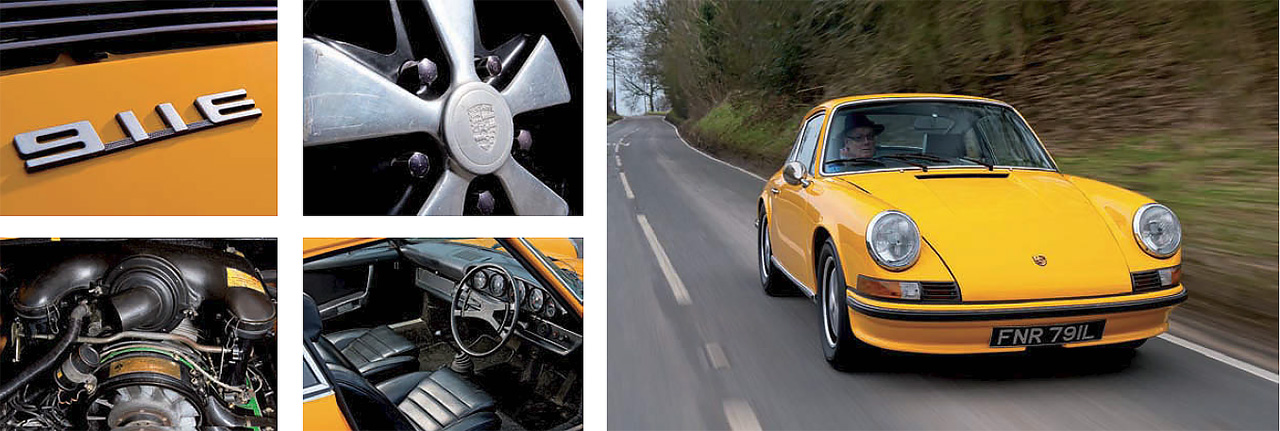
Signal Yellow 911E screams 1970s cool. The subject of a recent restoration, it’s the best looking of the trio. Sharp throttle response appealed to our man Tipler
Perceived at the time as significant, the upgrades are in fact relatively slight, given the quantum leap of the 2.7 Carrera RS, launched in ’73, with its plastic bumpers (in Lightweight guise), ducktail spoiler and capacity hike. The 2.4-litre cars are actually 2341cc, a longer-stroke incarnation of the preceding 2.2 flat-six. A lower 8:1 compression ratio enables it to run on 91-octane fuel, and there’s a larger fuel tank, moulded around the new spacesaver tyre. For 1972 the oil tank moved inboard of the right rear wheelarch, resulting in the introduction of an external oil filler cap. This quickly became the bane of unwitting pump attendants (in the days before ubiquitous selfservice) and so notorious that, for ’73, the oil tank reverted to its previous location behind the rear wheelarch.
The 2.4s were first to receive the new 915 five-speed gearbox, and the Sportomatic box was only available to special order. Being the base model, the T is fuelled by Zenith 40 T1N carburettors, develops 130bhp and goes from 0-60mph in 9.9 seconds, topping out at 125mph.
Next is the E, which stands for Einspritzung, signifying Bosch mechanical fuel-injection. At the time this was considered pretty sophisticated kit, and performance improved accordingly: 165bhp and 0-60mph in 8.8 secs, with a 135mph maximum.
The range-topping S was most easily identified by its front chin spoiler and no bumper overriders. It developed 190bhp and sprinted from 0-60mph in 7.8 secs, maxing out at 144mph. Back in the day, the differing specs were reflected in showroom prices. Now though, condition and provenance are key motivators and a pristine T should be worth more than an ‘average’ S.
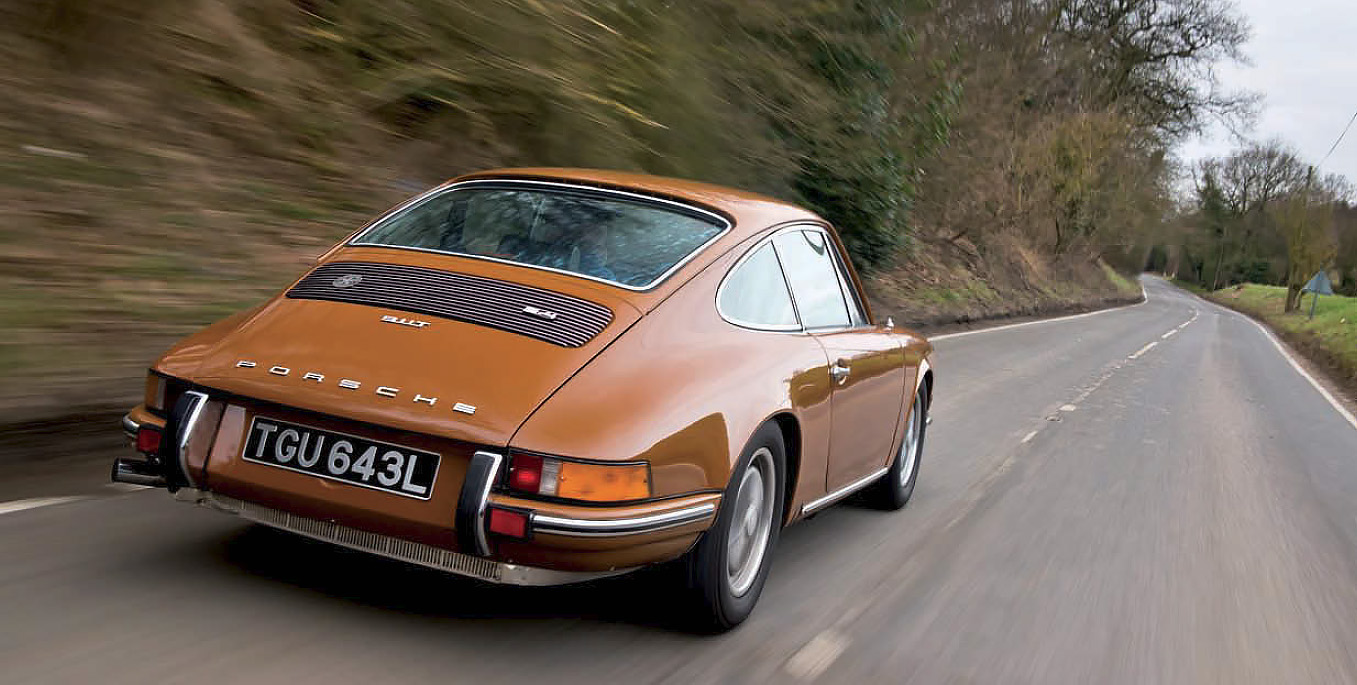
Today’s values have risen more or less proportionally with the original prices: in 1972 a 911T was priced at Dm24,480 (£10,853, or €12,516 at today’s rates), a 911E was valued at Dm31,000 (£13,744, or €15,850), and the S cost Dm32,480 (£14,400 or €16,606), so there was a significant Dm8000 (£3546, or €4090) difference between the T and the S.
Paul Stephens propounds current values: ‘as a top-end benchmark, a right-hand drive Lightweight 2.7 RS would make in the order of £350,000 – because there were only 17 of them; the very best RS Touring would be £250K because there were only 100 in right-hand drive. The 2.4 S is very similar to an RS Touring in its specification, interior and suspension, though they didn’t have the ducktail engine lid, and they were 190bhp instead of 210bhp. After that they were pretty similar, and a top line car would make upwards of £125,000.’ Paul lays down another marker for the middle ground:
‘The best 2.2S would fetch £80,000, and you could pick a 2.4S up for that, but I’d rather you bought one that needed complete restoration for less, or one that’s been correctly restored for top-line money; the ones in the middle have only been half done, and they’re hanging onto the coat tails of the ones that have been done properly, and hoping no one notices.
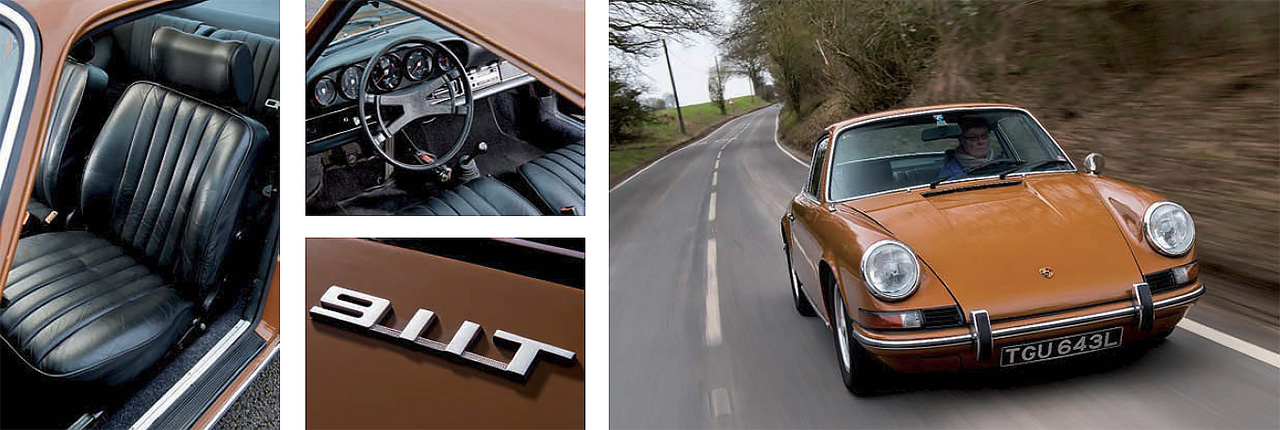
US-specification means this 911T runs mechanical injection (making it a T/E). Sepia Brown is gaining in popularity. The T proved to be Tipler’s favourite…
‘The £60-80,000 cars are probably not a good place to put your money, frankly, as they’re the cars that were poorly done when they weren’t so valuable. It wasn’t so long ago that you could buy a 2.4S for under £20,000. Now, though, Ss are a minimum of £50,000 upwards, whatever they’re like.’
Let’s put the S on one side for a moment and consider the next one down: ‘The 1973 Porsche 911 2.4E makes the most sense in many ways because it offers 80 per cent of the S driving experience for less money, and the very best should be about £70-75,000, so potentially you’ve saved yourself £50K. There’s kudos in owning an S, but the thinking man’s money would go on the E, actually. You could buy something scruffy for £30,000, something you can use, and at that level Ts don’t make a lot less, whereas the best T would struggle to go through £50,000 unless it was something truly exceptional.
‘In the UK Targas are slightly less, though the Dutch and the Germans have got a bit of a fetish for Targas and they’re genuinely very rare – but they just don’t make the money.’ Paul stresses that the figures he’s quoting are for: ‘cars that are top-of-the-pops, and it would be perfectly feasible to find average examples at half of what I’m saying in each case.’ But not in his showroom.
Nevertheless, there are superior 2.4s out there. ‘The market is rampant,’ says Paul. ‘There’s a definite homing-in on original cars at the moment. Investors like something tangible, and like fine art where the more provenance the object has the more it’s worth, it’s the same with these cars. Porsches weren’t high-volume products in the ’70s, and most people were driving British stuff so Porsche was still quite an expensive, exclusive car, and there certainly aren’t that many in right-hand drive.’
Originality is a big factor when searching for one of these 911s, and that’s a matter of degrees. ‘To find one that hasn’t had any paint is extremely rare, though we did have a 1973 Porsche 911 2.4T in just before Christmas and that was almost entirely original apart from some bad paint repairs, but essentially it had never been apart.’ When these cars languished in old Porsche purgatory they were often subjected to a spot of pimping: wide arches and fat wheels to convey the RSR look, perhaps, or converted into RS replicas; ‘the 2.4s have the same bottom end and fuelinjection as an RS, so replace barrels and pistons and change the pump and you’re away.’ That seemed like a good idea a few years ago when they were cheap, but now they’ve gone up dramatically in their own right it’s debateable whether it’s worth it.
Let’s take a look at the cars Paul’s selected for us. The T is a left-hooker, registered in December ’72, with all the stamps in its original service book. Its mechanical fuelinjection reveals it’s a US import – a T/E, if you will – manifest in power delivery akin to an E. Four years ago it had a drivetrain overhaul and received a lot of attention to its shell: ‘The common water traps that corrode have all been done, and it should last longer than they did before,’
Paul vouches. ‘They’ve been retreated, re-primed and waxoiled afterwards, all because of a tiny bubble of rust in the sills, so that was all replaced.’
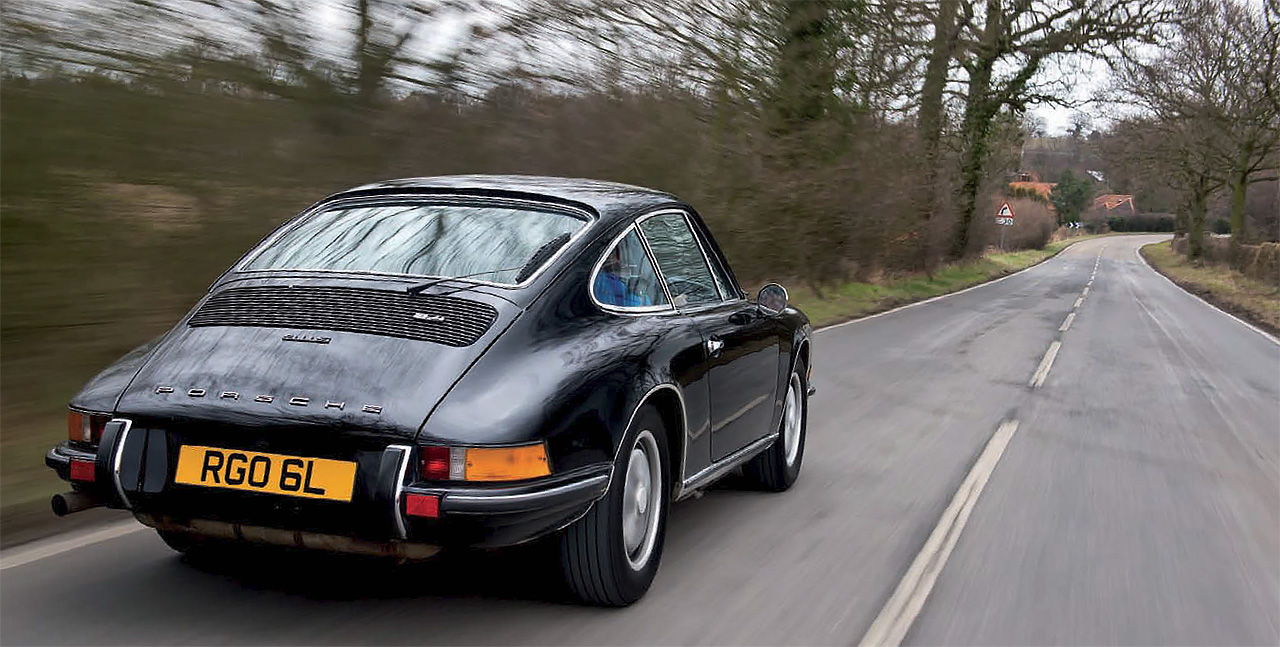
The E is a non-sunroof coupé that was painted white at some point, with some incorrect parts fitted, but it’s just been correctly restored to Signal Yellow. What goes around comes around, and flower-power yellow is cool again now and, prior to painting, the E’s engine bay, luggage compartment and wheel arches were all attended to. It, too, has just undergone a major mechanical overhaul, and the original Fuchs are currently being re-anodised; they have a less pronounced rim offset than the substitutes currently fitted. The cabin still awaits the door cards with the correct door pockets, though the original Recaro seats are present, which is a rare bonus.
The black S looks and feels like the most used of the three, and that’s because it hasn’t been restored to the same extent as the other two. It’s a ‘matching numbers’ car, owned by father and son from new, and one of the first six 2.4 Ss delivered to UK concessionaires AFN in ’73.
The licence plate – RGO 6L – is rather special, too, being the sixth of its siblings in the 1-8 RGO sequence. Cosmetically it’s far from pristine, and probably wants £30K spending on it to make it perfect, after which Paul predicts it could be worth £115K.
Appreciating the performance of these cars is all a matter of degrees, and the margins are fine. As Paul explains, ‘a sweet S with a freshly-rebuilt engine can be as much fun as the 1973 Porsche 911 RS, possibly more so because it’s comfortable and the ride’s not so harsh and uncompromising. Back then the S was perceived as being much faster than the E or the T, but in fact they are very close to the S in terms of performance. By today’s standards there’s not a huge amount in it.
‘The reality is, you think, “Well, do I really want to wring the necks of these cars?” and the answer is probably not. It’s not about how fast you are going, it’s about how you are going fast!’ The downside of going quickly in a 2.4 S is fuel consumption: a hard-driven classic returns around 15mpg, which when petrol prices were more modest might have been acceptable, but won’t be tolerated for long now.
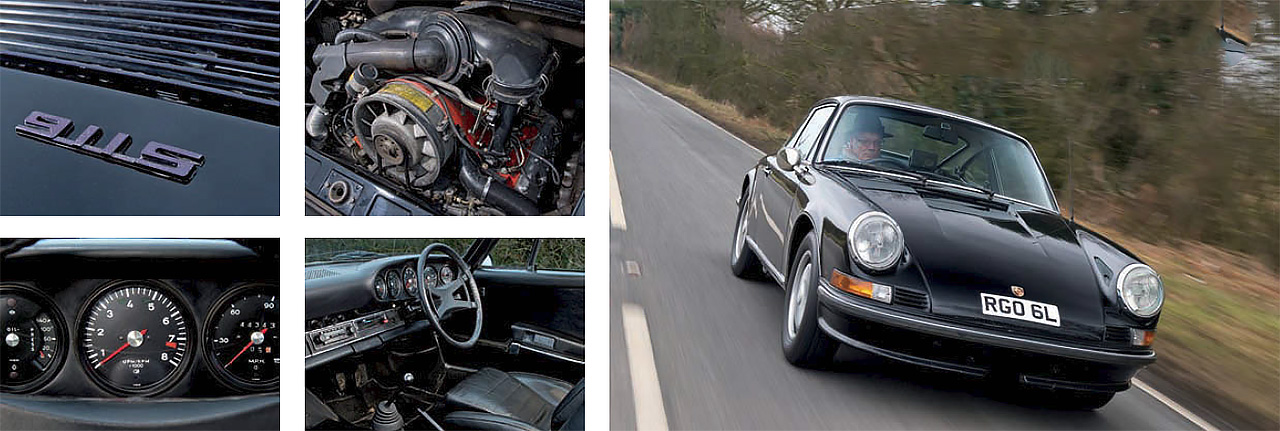
If you can’t afford a Carrera RS, then a 1973 2.4 S is the next best thing – and at a fraction of the price. This one-family example ticks all the right boxes…
Nevertheless, everyone’s allowed a stint with the rosetinted specs, as Paul avers: ‘to go fast in an S is the dream, but you can also get the E and the T to a similar level of look and feel. They share many of the same components, so it’s only a few tweaks and details that make the S that bit more exciting. The 1973 Porsche 911E is a delight, and it’s easier to drive than more modern cars.’ Maybe so, but I find it a tad flighty, probably because its suspension geometry has yet to be adjusted after its restoration.
Sitting in the Sepia Brown T, my head is touching the roof so I would have to do something about the seating position – change the seat or perhaps lower its mounts. It’s a left-hooker, and there’s incessant feedback through the large diameter steering wheel which demands constant attention. It tucks in nicely, though I don’t so much turn into corners as waltz round with my Porsche partner. The fuel-injected engine of this US-spec T revs smoothly, giving pleasingly brisk acceleration, and the gearchange is nicely weighted so that the shift lever pops into place just so. It’s hard to tell what the revs are doing because the tacho needle is fluctuating quite wildly: at an indicated 4000rpm
I’m only doing about 70km/h, so it’s way out. By contrast with the T, you sit nice and low in the black 1973 Porsche 911 2.4 S, and it’s very comfortable in the period Recaros. This is much more on the button: I blip the throttle and the flatsix zings; the controls seem more precise than they do on the brown T. It’s a very nice car to drive: there’s no play in the steering; it’s more direct than the other two cars.
Everything is planted: the ride is firmer, turn in more precise, the steering wheel less fiddly, and it delivers its power a little bit higher up the rev range, as you would expect with an S.
The black car is the hooligan of the trio because even at 144,000 miles (the engine was overhauled at 139K) it’s still fresh and in its original spec, but it encourages greater liberties to be taken in the twisty bits – there’s not quite the sense of biting my bottom lip and sawing the wheel like a circus juggler. Stopping is a serious business, and with all three I have to stand on the brakes to an extent. The T seems to have the best brakes, the E is adequate, but in an emergency stop situation they are not fantastic. I have to really make sure the handbrake is lying flat on the tunnel too, but the red warning light nudges me on that score.
Now for the yellow E. Once again I’m sitting rather higher than I would like, but I suppose that’s because the seat is newer. It’s fitted with a period Motorola pushbutton radio and new carpets, but there’s an irritating squeak when I turn the steering wheel. Aurally it sounds the sharpest of the three, so although it steers more like the jiggling brown car, the engine is more responsive than either of the other two. So, in summary, I like the driving position of the T because it’s a left hooker, though not the seats, I like the steering of the S and I like the throttle response of the E, and I think at first that the yellow car would emerge as my favourite because of its sensitive handling and responsiveness.
After driving them again for the photos, I revise my opinion and find in favour of the T as it’s the most responsive on the throttle. The S has the most comfortable seats and feels the most planted of the three because there’s not so much jiffling with the steering wheel. They’re all fine cars, but some aspects are marginally better than others.
There’s no such thing as a cut-price 911, which is a comforting thought if you own one: but even the undervalued Porsche 912 is regarded with a speculative weather eye nowadays, not merely as the basis for a historic competition car, but as a true classic Porsche in its own right, rather than the 911’s Cinderella sister.
If, in 1973, you told someone that, forty years down the line, the 911 would be worth almost ten times its showroom price they’d have thought you were crazy. The lunatics have finally taken over the asylum.





